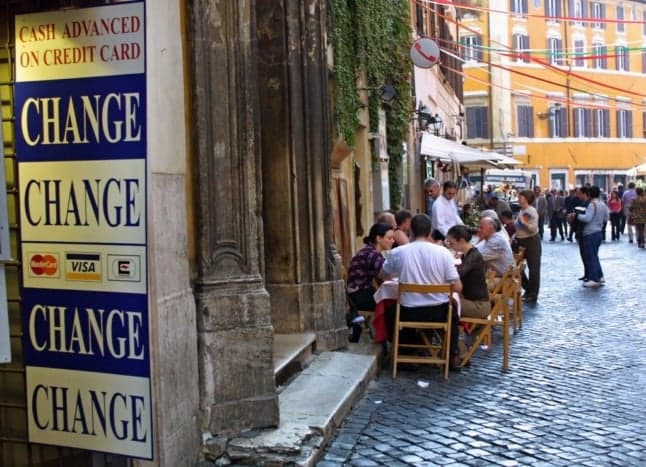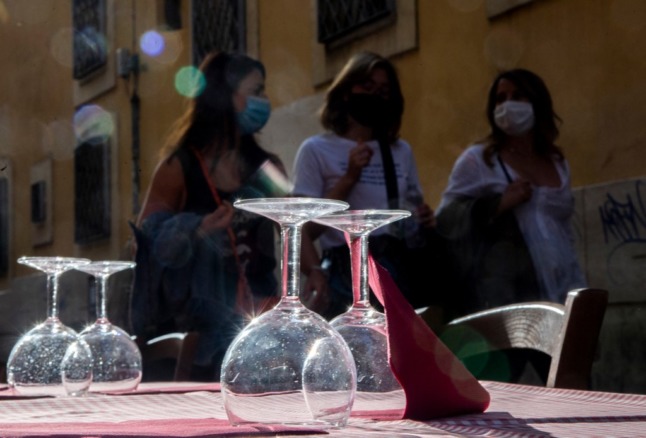OPINION: Want to eat well in Italy? Here’s why you should ditch the cities

Most international visitors to Italy's major cities are no doubt hoping to sample the country's famed culinary delights. But if you want to savor the best of real Italian cuisine you'll need to travel further afield, writes Silvia Marchetti.
Friends visiting Rome often ask me which are the best places to eat alla Romana - aka, the traditional Roman way - and each time I find myself short of suggestions.
Restaurant names do pop into my head but none serve the real thing any longer, not even those in the picturesque old Trastevere neighborhood.
It’s sad to say but the trattoria and hostaria, the typical Roman-style taverns, have almost disappeared. Surviving ones have retained just the white and red checkered tablecloths, wooden benches and paper napkins of the past.
READ ALSO: The common Italian food myths you need to stop believing
The truth is, if you want to eat like a real Roman you should ditch the Eternal City and head towards the many quaint villages that surround the capital, blending the pleasures of day-tripping and nature walks with savoring traditional recipes.
Food in big cities has lost the authenticity and flavor of tradition which survives in the countryside, where housewives still make pasta by hand and use locally grown veggies and fruit and fresh dairy products. Food miles don’t exist.
Italians love their fuori porta (‘out of the city walls’) weekends when they get to relax and detox in pristine valleys and sleepy villages, picking small-scale eateries. According to a recent survey, 91 percent of Italians prefer restaurants serving organic dishes with locally sourced ingredients.
These establishments are often referred to as agriturismi, a type of tavern-farm also offering simple accommodation that has become even more popular in times of Covid.
There are good reasons why so many Italians flee from towns for a bite of genuine cuisine. Eating in big cities, especially in the historical center of Rome, is no longer such a pleasant experience - except of course if you’re a Michelin-starred amateur. I’m not saying all city places offer poor-quality food, just that the majority has degraded.

A restaurant in Rome's Trastevere. Photo: Tiziana Fabi/AFP
When I go for a walk near the Pantheon or Piazza Navona I can’t stand seeing photos of dishes displayed behind restaurant windows to lure customers in. The images of big fat plates of spaghetti all’Amatriciana and carciofi alla Giudia (fried artichokes) described in English on huge cardboard signs and shiny plastic posters are meant to make passers-by drool.
Even worse, recently I’ve seen real dishes cooked early in the morning or the day before, displayed like gruesome art installations at the entrance. They look gluey and smell terrible, almost on the verge of rotting. My stomach churns in disgust each time.
Also, most tourist menus in Rome feature images of iconic Italian dishes adapted to foreign tastes. The cotoletta alla Milanese is drawn or photographed served inside a panino (Italian sandwich) like a hamburger. And to please American tourist kids bored with sightseeing, there are now even non-Italian ice-cream flavors such as Oreo, Mars and Smarties.
READ ALSO: How to spot good quality gelato in Italy – and how to suss out the fakes
The same thing goes for Florence. Last time I visited and dined outdoors at the foot of the Duomo cathedral, the waiter said they didn’t have a menu written in Italian but made great spaghetti bolognese - which, by the way, doesn’t exist (the correct name is tagliatelle al ragù and it’s not a Florentine staple). My eyebrows raised and I left.
Meanwhile in Venice, several bistros serve slices of pizza baked the day before and reheated, yet advertised on billboards as ‘the original Neapolitan pizza’. This, as the name suggests, is best made in Naples and the Campania region.
City restaurants should really stop showcasing food as bait because it kills the soul of Italian cuisine - which is what foreigners love.
But if you escape the crowds, get outside big cities and explore ‘small-scale Italy’ you’ll easily be able to get a taste of home cooking. For example, I recently toured Ciociaria, a wild patch of land south of Rome where shepherds and outlaws used to be the sole inhabitants.
It’s a foodie heaven. Family-run dairy farms make fresh ricotta and super-tasty pecorino sheeps’ cheese each morning, and they’ve opened small taverns serving handmade bucatini pasta with wild boar sauce and porcini mushrooms fried in breadcrumbs.
READ ALSO:
- TRAVEL: Picnicking Roman-style in the Castelli Romani
- Ten must-do day trips from Rome
- 14 reasons why Lazio should be your next Italian holiday destination
There are rare delicious vegetables with weird names I’d never heard, while the cured meats are seasoned in cellars. Sausages hang from ceiling hooks to dry. Bread is made in centuries-old mills, and ancient vineyards dating back to pre-Roman times have been recovered.
Eating high-quality Italiano means also savoring the ‘slow food’ philosophy and the culinary knowledge handed down through generations.
There’s also another key issue. Prices in rural areas are also very cheap when compared to those of cities. And with the plus point that you get to avoid the usual tourist rip-offs like paying 600 euros for lunch in a chic Roman restaurant or 42 euros for three ice-cream cones.
The last time I climbed the Spanish Steps the street drink vendors at the top wanted 6 euros for a half-liter bottle of water - and it wasn’t even cold.
Overcharging tourists never pays off. It only debases the greatness and reputation of Italian food.
Comments (6)
See Also
Friends visiting Rome often ask me which are the best places to eat alla Romana - aka, the traditional Roman way - and each time I find myself short of suggestions.
Restaurant names do pop into my head but none serve the real thing any longer, not even those in the picturesque old Trastevere neighborhood.
It’s sad to say but the trattoria and hostaria, the typical Roman-style taverns, have almost disappeared. Surviving ones have retained just the white and red checkered tablecloths, wooden benches and paper napkins of the past.
READ ALSO: The common Italian food myths you need to stop believing
The truth is, if you want to eat like a real Roman you should ditch the Eternal City and head towards the many quaint villages that surround the capital, blending the pleasures of day-tripping and nature walks with savoring traditional recipes.
Food in big cities has lost the authenticity and flavor of tradition which survives in the countryside, where housewives still make pasta by hand and use locally grown veggies and fruit and fresh dairy products. Food miles don’t exist.
Italians love their fuori porta (‘out of the city walls’) weekends when they get to relax and detox in pristine valleys and sleepy villages, picking small-scale eateries. According to a recent survey, 91 percent of Italians prefer restaurants serving organic dishes with locally sourced ingredients.
These establishments are often referred to as agriturismi, a type of tavern-farm also offering simple accommodation that has become even more popular in times of Covid.
There are good reasons why so many Italians flee from towns for a bite of genuine cuisine. Eating in big cities, especially in the historical center of Rome, is no longer such a pleasant experience - except of course if you’re a Michelin-starred amateur. I’m not saying all city places offer poor-quality food, just that the majority has degraded.

When I go for a walk near the Pantheon or Piazza Navona I can’t stand seeing photos of dishes displayed behind restaurant windows to lure customers in. The images of big fat plates of spaghetti all’Amatriciana and carciofi alla Giudia (fried artichokes) described in English on huge cardboard signs and shiny plastic posters are meant to make passers-by drool.
Even worse, recently I’ve seen real dishes cooked early in the morning or the day before, displayed like gruesome art installations at the entrance. They look gluey and smell terrible, almost on the verge of rotting. My stomach churns in disgust each time.
Also, most tourist menus in Rome feature images of iconic Italian dishes adapted to foreign tastes. The cotoletta alla Milanese is drawn or photographed served inside a panino (Italian sandwich) like a hamburger. And to please American tourist kids bored with sightseeing, there are now even non-Italian ice-cream flavors such as Oreo, Mars and Smarties.
READ ALSO: How to spot good quality gelato in Italy – and how to suss out the fakes
The same thing goes for Florence. Last time I visited and dined outdoors at the foot of the Duomo cathedral, the waiter said they didn’t have a menu written in Italian but made great spaghetti bolognese - which, by the way, doesn’t exist (the correct name is tagliatelle al ragù and it’s not a Florentine staple). My eyebrows raised and I left.
Meanwhile in Venice, several bistros serve slices of pizza baked the day before and reheated, yet advertised on billboards as ‘the original Neapolitan pizza’. This, as the name suggests, is best made in Naples and the Campania region.
City restaurants should really stop showcasing food as bait because it kills the soul of Italian cuisine - which is what foreigners love.
But if you escape the crowds, get outside big cities and explore ‘small-scale Italy’ you’ll easily be able to get a taste of home cooking. For example, I recently toured Ciociaria, a wild patch of land south of Rome where shepherds and outlaws used to be the sole inhabitants.
It’s a foodie heaven. Family-run dairy farms make fresh ricotta and super-tasty pecorino sheeps’ cheese each morning, and they’ve opened small taverns serving handmade bucatini pasta with wild boar sauce and porcini mushrooms fried in breadcrumbs.
READ ALSO:
- TRAVEL: Picnicking Roman-style in the Castelli Romani
- Ten must-do day trips from Rome
- 14 reasons why Lazio should be your next Italian holiday destination
There are rare delicious vegetables with weird names I’d never heard, while the cured meats are seasoned in cellars. Sausages hang from ceiling hooks to dry. Bread is made in centuries-old mills, and ancient vineyards dating back to pre-Roman times have been recovered.
Eating high-quality Italiano means also savoring the ‘slow food’ philosophy and the culinary knowledge handed down through generations.
There’s also another key issue. Prices in rural areas are also very cheap when compared to those of cities. And with the plus point that you get to avoid the usual tourist rip-offs like paying 600 euros for lunch in a chic Roman restaurant or 42 euros for three ice-cream cones.
The last time I climbed the Spanish Steps the street drink vendors at the top wanted 6 euros for a half-liter bottle of water - and it wasn’t even cold.
Overcharging tourists never pays off. It only debases the greatness and reputation of Italian food.
Join the conversation in our comments section below. Share your own views and experience and if you have a question or suggestion for our journalists then email us at [email protected].
Please keep comments civil, constructive and on topic – and make sure to read our terms of use before getting involved.
Please log in here to leave a comment.